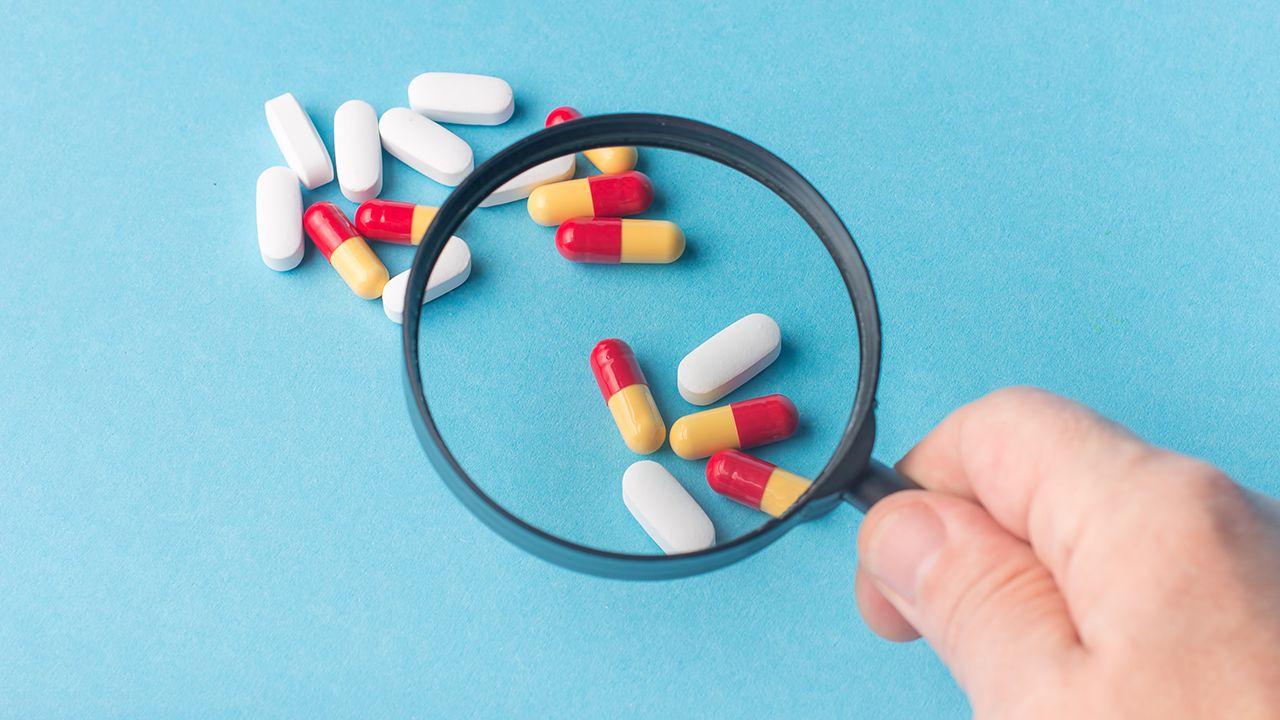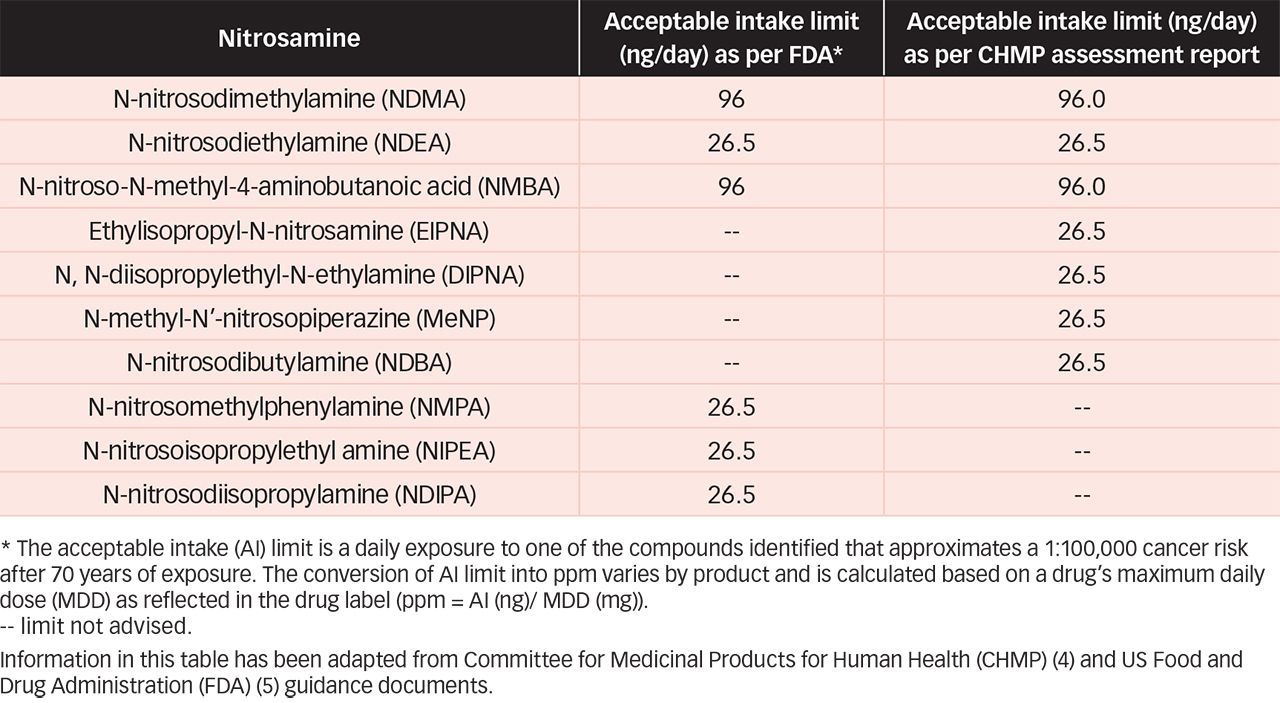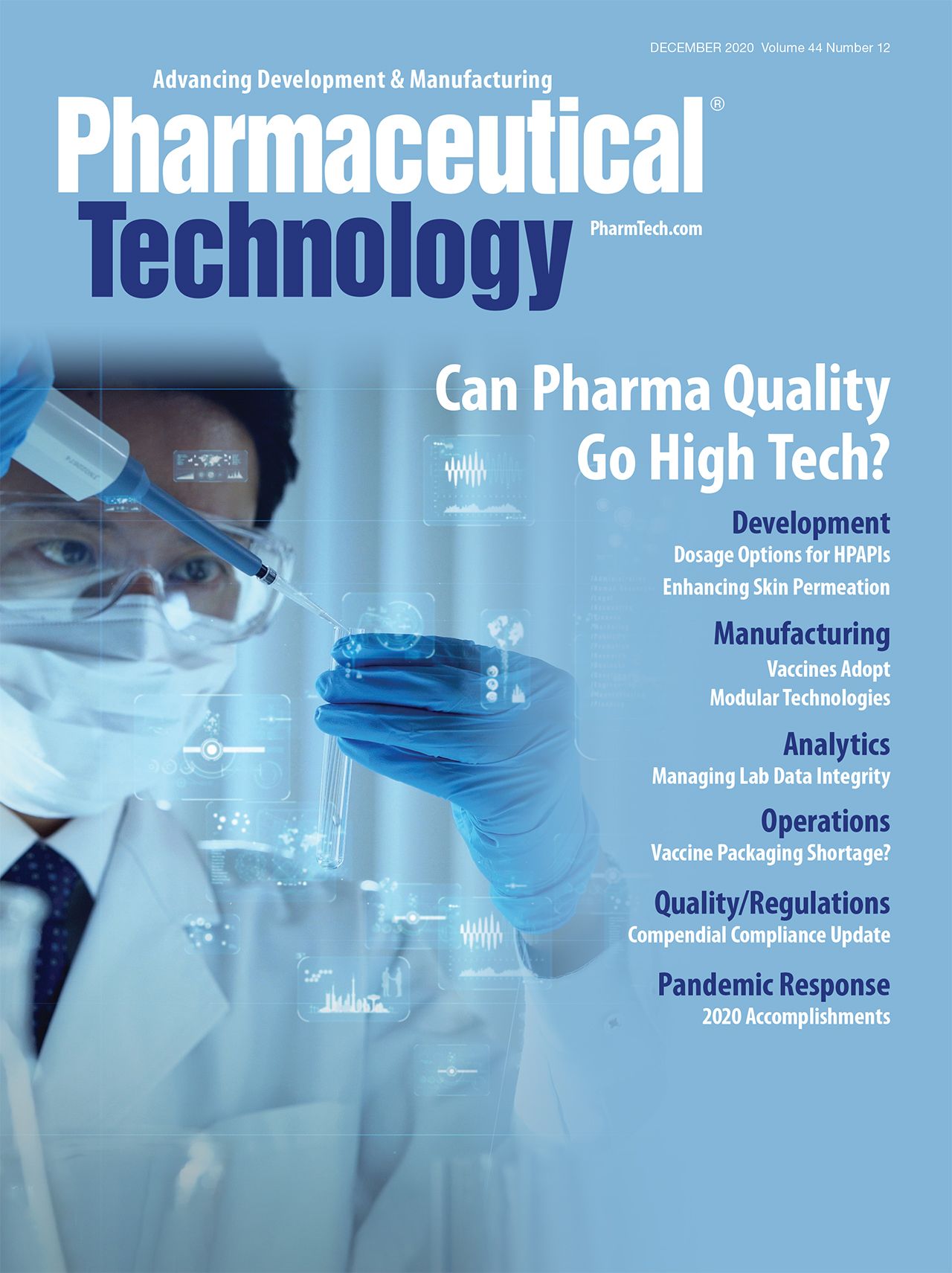Editor’s Note: This article was published in Pharmaceutical Technology Europe’s December 2020 print issue.
Nitrosamine Impurities in Medicinal Products
Industry should improve the standards on application of risk management tools in light of the cases of nitrosamine impurities.
Aleksey 159 - Stock.adobe.com

Medicine regulatory authorities were alerted of the presence of the nitrosamine impurity, N-nitrosodimethylamine (NDMA), in products containing valsartan in July 2018. Valsartan is an Angiotensin II Receptor Blocker (ARB) belonging to a class of products commonly referred to as sartans. The medicines containing valsartan API were immediately recalled, and a regulatory review was triggered in accordance with Article 31 of Directive 2001/83/EC (1). Further nitrosamine impurities were detected in other sartan drugs as well as in pioglitazone, ranitidine, nizatidine, and metformin products.
The use of the solvent dimethylformamide (DMF) alongside other reagents was ascertained as the main source of nitrosamine impurities. It is the concurrent presence of dimethylamine, a degradation product of DMF along with sodium nitrite in the presence of an acid which generated NDMA. Other contamination factors included solvent, reagents, and poorly cleaned manufacturing equipment already contaminated with nitrosamines, leading to potential cross contamination. The Committee for Medicinal Products for Human Use (CHMP) immediately set interim limits for NDMA in APIs based on acceptable intake calculated in accordance with International Council for Harmonization (ICH) M7 (2). All concerned marketing authorization holders (MAHs) were subsequently required to make necessary changes to their API manufacturing process to minimize nitrosamine contamination.
The European network (European Commission, the European Medicines Agency [EMA], national competent authorities in the European Economic Area [EEA], and the European Directorate for the Quality of Medicines and Healthcare [EDQM]) decided that the outcome of the Article 31 review of sartans must be considered by all MAHs for medicines containing chemically synthesized active substances (and later on biological products) through an Article 5(3) procedure to evaluate the risk of nitrosamines being present in their product and to take appropriate risk mitigation measures.
In parallel, the European network engaged in a lessons learnt exercise (3) and made recommendations to reduce the potential of nitrosamine impurities being present in human medicines. The lessons learnt group made recommendations covering prevention, incident management, market surveillance, communication, and international cooperation. The group evaluated relevant guidelines and determined that certain amendments and clarifications would help both companies and regulators better assess the potential for impurities, such as nitrosamines. These aspects are discussed in more detail within this article.
Root causes of the presence of nitrosamines
Nitrosamines belong to a well-known group of carcinogens known as N-nitroso compounds because of their reactivity with DNA metabolizing into potent carcinogen diazonium ions. Nitrosamine formation lies in the oxidative release of the known nitrosating agents and subsequent nitrosamine formation by reaction with secondary and tertiary amines or dealkylated ammonium salts under acidic conditions.
The reagents, solvents, catalysts, and reaction conditions used during the tetrazole ring formation of sartans are the main causes for the presence of nitrosamines. Quenching of the starting material azide with nitrosating agent in the presence of solvent DMF and the sartan product to ensure fast and complete depletion of explosive hydrazoic acid is favoured for process safety reasons. This combination of reagents was a key pathway for nitrosamine formation and was successfully prevented through isolation of the drug substance before precarious quenching.
Importantly during the Article 31 review, it was noted that sodium nitrite was seldom identified in the drug substance documentation, or it was briefly listed as a raw material and omitted from the drug substance process description. In some cases, sodium nitrite was added in the process as part of a scale up activity, introduced through variation procedures, which could be categorized as a minor change providing the scale up is up to 10-fold and the API specification is unchanged; thus lacking rigorous agency evaluation leading to potential failure in risk identification.
The review also found that the use of recycled solvents, reagents, or catalysts from third-party suppliers were further causes of nitrosamine contamination, as were good manufacturing practice (GMP) violations that resulted in cross-contamination in multi-purpose facilities and operator-related issues, such as inadequate phase separations. Contamination of finished products packaged in nitrocellulose blisters was also discovered. In this case, elimination of the nitrocellulose primary packaging through a minor regulatory change to the container closure system eliminated the risk of nitrosamine formation.
Degradative mechanisms for amine generation and nitrosamine formation without considering the potential presence of secondary and tertiary amine impurities in the applied solvents (such as dimethylformamide [DMF] or N-methylpyrrolidone), reagents (such as trialkyl amines), and catalysts (such as quaternary ammonium salts) were the predominant focus of the Article 31 root cause analysis as the most plausible cause for the origin of nitrosamines in sartans. These multiple root causes pose a risk of nitrosamine formation and should be avoided in manufacturing processes unless proved necessary.
Lessons learnt and recommendations
The efficacy and robustness of the European network guidelines, developed in conjunction with international partners—CHMP’s Guideline on the Chemistry of Active Substances, ICH Q11, ICH Q3A (R2), and ICH M7 (R1)—were challenged during the investigations subsequent to the contamination of nitrosamines in sartans and other APIs. In light of the Article 31 exercise for the sartans products, a series of lessons learnt were published on the EMA website (3).
- The importance of the possible side reactions leading to formation of nitrosamines as well as the thorough investigations of the potential interactions between all the materials and degradants necessitates more detailed information to be present in the regulatory dossiers.
- The need for transparent exchange of technical information through improved quality agreements between the APIs manufacturers, third-party manufacturers, and MAHs during process development, supplier qualification, but also subsequently during the lifecycle of the product through better quality audits. Confidentiality aspects between the MAHs, active substance master files (ASMFs) holders, and certificate of suitability (CEP) of API substances can significantly hamper the scientific evaluation required.
- The correct class of variations were not always selected due to lack of clarity in the conditions to be fulfilled. In particular, in case of Type IA category, an in-depth scientific regulatory assessment may be missed during evaluation.
Potential revisions to the guidelines on responsibilities of MAHs and manufacturers include (3):
- Clarify the MAHs responsibilities, versus finished product manufacturers, API manufacturers, ASMF holders, and API CEP holder’s responsibilities throughout the lifecycle of the product.
- Facilitate information exchange between CEP or ASMF holders and MAHs regarding impurity formation so that the MAH can take full responsibility for the quality of their products.
- Cultivate the importance of in-depth development studies and product knowledge to strengthen the oversight of the entire supply chain.
- Consolidate the quality agreements between MAHs and API manufacturers and request detailed audits of API and intermediate manufacturers, improve the quality of the qualified person (QP) declaration system to increase reliability.
- Re-evaluate requirements in the European Union variations guideline for conditions/documentation for variations associated with adding or changing API manufacturers and manufacturing processes (including those documented in ASMFs and CEPs); in particular, for Type IA minor changes, which could result in insufficient scientific in-depth assessment by the regulators.
- MAHs to generate and submit their own information on impurities regardless of the route of API registration.
Potential revisions to the guidelines for controlling impurities are as follows (3):
- Publication of detailed information about potential sources of nitrosamine impurities and other ‘cohort-of-concern’ compounds, as defined in ICH M7 (R1) (2), for substances containing some structural groups with high mutagenic or carcinogenic suspected potency.
- Addition of stringent requirements to the European general monograph on substances for pharmaceutical use to mitigate the risks of nitrosamines.
- Strengthening of some of the development studies provisions of the European guideline on the chemistry of active substances to prevent the generation of cohort-of-concern compounds and implementation of appropriate risks mitigation measures. It could include a requirement for the MAHs to submit a justification for the proposed manufacturing processes and mitigation measures as part of the regulatory dossier.
Potential amendments to ICH guidelines are as follows (3):
- ICH M7—to elaborate control of impurities requirements, implement mitigation measures, and establish limits for cohort-of-concern compounds as well as considering retroactive application of the guideline to legacy products
- ICH Q7—to limit the use of reagents or recovery processes that may be a source of cohort-of-concern compounds and clarify mitigation measures
- ICH Q9—to provide benchmark expectations for suitable and robust risk assessments.
Additional clarifications in GMP guidelines regarding regulatory expectations for technology transfers, supplier qualification, as well as qualification and validation of facilities processes for active substance manufacturing were also part of the group recommendations (3).
Recent recommendations for industry
In July 2020, the CHMP assessment report of the Article 5(3) on ‘nitrosamines impurities’ (4) was published providing recommendations for industry regarding the prevention of presence of nitrosamines in human medicines. Concomitantly, the US Food and Drug Administration (FDA) released a guidance concerning the control of nitrosamine impurities in human drugs (5). The CHMP assessment report and the FDA guidance advise API and drug product manufacturers to conduct risk assessments of their approved or marketed products and products with pending applications and take appropriate actions to reduce or prevent the presence of nitrosamines in their products.
The FDA guidance and the CHMP assessment report recommend the following acceptable intake (AI) limits for the nitrosamine impurities detailed in Table I. They also advise that manufacturers use these AIs when determining limits for nitrosamine impurities in APIs and drug products. The overall aim is to limit patient exposure to a total risk of not more than 1 in 100,000 life-time risk.
Table I. Acceptable intake limits for some specific nitrosamines in drug products.

API and drug product manufacturers should also take a three-step plan to mitigate nitrosamine impurities in their products:
- Assess the risk of nitrosamine impurities in APIs, marketed products, and products under approved and pending applications, and retain those in case requested; for licensed products, this step should be completed by 1 March 2021 for US medicines, by 31 March 2021 for EU chemical medicines and by 1 July 2021 for EU biological medicines.
- Conduct confirmatory testing when there is any risk for the presence of nitrosamine impurities using suitable analytical procedures as soon as risks are identified; for licensed products, this step should be completed by 1 Sept. 2023 for US medicines and confirmatory testing results should be reported as soon as completed for EU medicines.
- Report changes implemented to prevent or reduce nitrosamine impurities in APIs and drug products to agency; for licensed products, this step should be completed by 1 Sept. 2023 for US medicines, by 26 Sept. 2022 for EU chemical medicines and by 1 July 2023 for EU biological medicines.
In October 2020, EMA also requested all MAHs of metformin‑containing medicines to test their product before release to the market as a preventive measure to safeguard patients.
For pending applications, both agencies expect industry to initiate those mitigation steps and would request the applicant’s relevant risks assessments, and confirmatory test (if required) during assessment.
Reporting changes to regulators
As per FDA guidance, the drug manufacturers must report changes implemented to prevent or reduce nitrosamine impurities. Those changes must be directly documented by the impacted manufacturer in the applicant dossier in case the API is not covered by a DMF or through reference to relevant DMF amendments. Reprocessing or rework of any batch of API containing a nitrosamine should be reported in the DMF or application. Equally, changes to the drug product preventing nitrosamine formation must be notified through supplement to FDA by the application holder. Holders of pending applications must update their applications through submission of an amendment.
Likewise, the Co-ordination Group for Mutual Recognition and Decentralized Procedures—human (CMDh) requests the MAHs to introduce necessary changes to their API and/or finished products through the timely submission of appropriate variation(s) in accordance with the guideline on classification of variations. In case nitrosamine(s) are identified, the corresponding limit(s) as defined in Table I should be introduced in the finished product specifications. Relevant amendments pertaining to ASMF or CEP that are necessary to control nitrosamine impurities in the active substance and/or finished products should be considered for variation applications.
Conclusion
The sartans case substantiates the necessity for the pharmaceutical industry to improve the standards on application of risks management tools, particularly regarding post approval activities. The case also showed some of the potential risks associated with the lack of transparency between MAHs, API manufacturers, and others over patient safety and the shift required to increase transparency through revisions of the regulatory framework whilst ensuring safeguarding of confidential information. A number of the potential revisions to the key post approval guidelines considered by the lessons learnt group focus on thorough process understanding and risk evaluations even in the case of traditionally considered ‘minor changes’.
The recent CHMP report and FDA guidance advocate companies to take measures to limit the presence of nitrosamines in human medicines as far as possible and to ensure levels of these impurities do not exceed set limits. These measures will ensure that nitrosamines are either not present, or are present below levels identified to protect public health. Harmonized and innovative tools brought by regulators and thorough synthetic process understanding and control strategies honed by industry are key building blocks to continue to fulfil a common patient centric mission.
Acknowledgements
The authors would like to acknowledge Stuart Goodall, head of regulatory, Keira Ledger, associate regulatory director, (both at Kinapse Ltd, UK), as well as Vivek Tomar, associate regulatory cmc director (at Kinapse Ltd, India) for their assistance as acting reviewers of the article.
References
- Article 31 of Directive 2001/83/EC, Directive 2001/83/EC of the European Parliament and of the Council of 6 November 2001 on the Community code relating to medicinal products for human use (July 2019).
- ICH, M7 (R1) Assessment and Control of DNA Reactive (Mutagenic) Impurities in Pharmaceuticals To Limit Potential Carcinogenic Risk, Step 4 version (31 March 2017).
- EMA, EMA/526934/2019, Lessons Learnt from Presence of N-nitrosamine Impurities in Sartan Medicines (Amsterdam, 23 June 2020).
- EMA, EMA/369136/2020, Assessment report Procedure under Article 5(3) of Regulation EC (No) 726/2004, Nitrosamine impurities in human medicinal products (Amsterdam, 25 June 2020).
- FDA, Guidance for Industry, Control of Nitrosamine Impurities in Human Drugs (CDER, September 2020).
About the Authors
Stephanie Snow is CMC manager and Niamh Panesar is CMC senior manager, both at Kinapse Ltd, UK; and Rakesh Suman is consultant at Kinapse Ltd, India.
Article Details
Pharmaceutical Technology Europe
Vol. 32, No. 12
December 2020
Pages: 30–32, 49
Citation
When referring to this article, please cite it as S. Snow, N. Panesar, and R. Suman, “Nitrosamine Impurities in Medicinal Products,” Pharmaceutical Technology Europe 32 (12) 2020.
